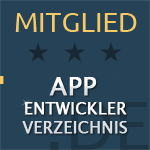
Insight

Insight

Insight
Test-driven Flutter development: A holistic approach to reliable apps


Julian Giesen
·
·
Monday, March 11, 2024


Julian Giesen
Errors in an app are not only annoying, they can also undermine users' trust. This is where testing comes into play. It allows us to thoroughly examine our apps, uncover potential weaknesses, and ensure functionality before they reach the users' hands.
In Flutter development, we have various testing approaches available. We can create unit tests, acceptance tests, widget tests, and integration tests in Flutter. Each of these approaches offers specific advantages and complements each other ideally to ensure comprehensive test coverage.
We will take a closer look at why testing is essential in Flutter app development and the crucial role it plays in the success of our projects.
What is BDD and TDD?
In software development, BDD (Behavior-Driven Development) and TDD (Test-Driven Development) are two prominent approaches that focus on quality assurance and testing code. Both methods share the common goal of developing high-quality software products, but they differ in their approach and focus.
BDD explained briefly:
Behavior-Driven Development (BDD) is an agile software development process that focuses on describing the behavior of software from the end user's perspective. At the heart of BDD are the requirements and behavior of the application. BDD places great importance on writing specifications in natural language to create a shared understanding among developers, project managers, and other stakeholders. These specifications then serve as a foundation for implementing tests and the actual code.
TDD explained briefly:
Test-Driven Development (TDD) is a development practice where tests are written before implementing functionality. The development process follows an iterative cycle of writing tests, implementing functionality, and refactoring the code. TDD shifts the focus to the software’s functionality while increasing test coverage. The goal of TDD is to produce high-quality code that meets requirements and is robust against changes.
Differences and similarities between BDD and TDD:
Although BDD and TDD pursue different approaches, they have some similarities. Both place a strong emphasis on test automation and the continuous integration of tests into the development process. Furthermore, both methods promote an iterative and incremental approach to software development.
However, the main difference between BDD and TDD lies in focus and the language used. While BDD focuses on the behavior of the application and specifications are written in natural language, TDD emphasizes implementing tests at the code level.
Overall, both BDD and TDD are valuable approaches to improving the quality and reliability of Flutter apps. By combining both methods, developers can ensure comprehensive test coverage while effectively meeting user requirements.
The Benefits of Writing Unit Tests
Writing unit tests is an essential part of a robust testing process in Flutter app development. These tests focus on verifying individual components or units of code to ensure they function as expected. Here are some of the main benefits of writing unit tests.
Improvement of code quality and stability: Unit tests help to increase code quality by ensuring that each function or method operates as expected. By continuously verifying individual units, potential errors can be identified and fixed early, before they become larger issues.
Early detection of bugs: By writing unit tests, developers can quickly identify and isolate bugs in their code. Since unit tests check specific functionalities, they allow for targeted debugging and minimize the impact of errors on other parts of the application.
Facilitation of refactoring and maintenance: Unit tests play an important role in the refactoring and maintenance of code. When developers make changes to the code, they can ensure that existing functionalities continue to work as expected by updating the unit tests or adding new ones. This makes it easier to improve the code without jeopardizing the application's stability.
In Flutter app development, unit tests provide an effective way to ensure the quality and reliability of our apps. By detecting errors early, improving code quality, and facilitating maintenance, unit tests significantly contribute to the development of high-quality and stable Flutter apps. It is important to view unit tests as an integral part of the development process and recognize their significance for the long-term success of our projects.
Acceptance Tests Combined with Widget Tests
Acceptance tests and widget tests are two important tools for ensuring the quality and functionality of our applications. By combining these two types of tests, we can achieve comprehensive test coverage and identify potential issues early.
Definition and purpose of acceptance tests: Acceptance tests are end-to-end tests that verify the behavior of an application from the end user's perspective. They simulate typical user interactions and check whether the application operates as expected. The purpose of acceptance tests is to ensure that the application meets users' requirements and expectations and provides a smooth user experience.
The role of widget tests in Flutter development: Widget tests operate at a lower level and focus on testing individual widgets or widget trees. They verify the behavior of user interface elements and ensure that they are rendered correctly and respond to user interactions. Widget tests are quick to execute and are well-suited for validating UI components.
Synergistic effects from the combination of both test types: By combining acceptance tests and widget tests, we can achieve comprehensive test coverage that encompasses both the behavior of the application and individual UI components. Acceptance tests assess the application from a higher level and ensure it meets requirements, while widget tests check the details of the user interface and ensure it functions correctly.
Furthermore, the combination of acceptance tests and widget tests allows for efficient bug localization. If an acceptance test fails, widget tests can help trace the root cause of the issue and target it for resolution. This leads to improved debugging and an overall higher quality of the application.
Utilization of the Flutter Package bdd_widget_test
To effectively implement the combination of acceptance tests and widget tests in Flutter app development, the Flutter Package bdd_widget_test is recommended. This package enables developers to integrate Behavior-Driven Development (BDD) with widget tests, thus improving test coverage at a higher level of abstraction.
The Flutter Package bdd_widget_test allows for the definition of acceptance tests based on BDD principles, making the tests easy to understand and maintain. By using natural language and descriptive scenarios, developers and stakeholders can collaboratively define the requirements and expected behavior of the application.
On one hand, it enables a holistic assessment of the application on various levels, from user interaction to the correct functioning of individual UI elements. On the other hand, it facilitates collaboration among developers, testers, and other stakeholders, as the tests are written in a comprehensible and mutually agreed-upon language.
By employing the Flutter Package bdd_widget_test, developers can optimally leverage the advantages of BDD and widget tests, ensuring that their Flutter apps meet the highest quality standards. With this powerful combination, they can catch bugs early, improve code quality, and provide an outstanding user experience.
The Advantage of Using Integration Tests
Integration tests play a crucial role in Flutter app development as they ensure that all components of the application work smoothly together and provide a consistent user experience across all platforms. Here are the main reasons why integration tests are essential.
The significance of integration tests for Flutter apps: Integration tests check the interaction of various components of a Flutter app, including UI elements, database access, network requests, and external services. They help uncover potential issues that may arise from the interaction of these components and ensure that the application functions as expected.
Testing the interaction of various components: In Flutter apps, numerous components work together to provide complete functionality. Integration tests allow developers to test these components in their real environment and ensure they interact seamlessly. This includes verifying data flows, user interactions, and integration with external services.
Ensuring a consistent user experience across all platforms: One of Flutter's major strengths is the ability to create cross-platform apps that function consistently across different devices and operating systems. Integration tests help ensure that the app provides a uniform user experience on all supported platforms and behaves the same.
By utilizing integration tests, developers can ensure that their Flutter apps function flawlessly and meet users' requirements. They provide an additional layer of security to detect and fix potential problems early before the app is released. Overall, integration tests are an indispensable part of a comprehensive testing process and significantly contribute to the quality and reliability of Flutter apps.
My Approach to Testing Strategy in Flutter Apps
As an experienced app developer, a well-thought-out testing strategy is crucial for me to ensure the quality and stability of my Flutter apps. My approach to testing strategy includes integrating BDD and TDD as well as practical tips and recommendations I have learned from my own projects and the industry.
Description of my testing approach considering BDD and TDD: My testing approach is based on a combination of Behavior-Driven Development (BDD) and Test-Driven Development (TDD). I first define the requirements and expected behavior of my application using BDD. Then, I write widget tests and unit tests according to the TDD method to ensure that each component of my app functions properly. By employing this iterative approach, I can identify potential issues early and ensure my app meets the requirements.
Practical tips and recommendations for implementation: When implementing my testing strategy, I ensure that the tests are easy to understand, maintain, and scale. I invest time in creating meaningful test cases to facilitate collaboration among other developers. Additionally, I utilize automation tools and continuous integration to optimize the testing process and enhance the efficiency of my development work.
Success stories from my projects or the industry: In my own projects, I have successfully applied my testing approach, significantly improving the quality and reliability of my Flutter apps. For instance, by implementing integration tests, I was able to detect and fix errors early before they became major issues. Furthermore, I have heard success stories in the industry where companies have shortened their development cycles and increased user satisfaction through a consistent testing strategy.
Overall, my testing approach enables comprehensive test coverage and contributes to ensuring that my Flutter apps meet the highest quality standards. By combining BDD and TDD, practical implementation tips, and successful examples from practice, I have created a solid foundation for developing high-quality and reliable apps that meet my users' expectations.
Summary
Tests are the foundation of any successful Flutter app. They help us avoid bugs, improve code quality, and strengthen our users' trust. By having a consistent testing strategy, we can ensure that our apps meet the highest quality standards and provide an outstanding user experience.
Key Takeaways:
BDD and TDD provide a structured approach to developing Flutter apps by ensuring that both user requirements and code functionality are taken into account.
Writing unit tests allows us to improve code quality, detect bugs early, and facilitate application maintenance.
The combination of acceptance tests and widget tests offers comprehensive test coverage and supports the development of a user-friendly interface.
Integration tests play an important role in ensuring that all components of a Flutter app work smoothly together and provide a consistent user experience.
As an app developer, project manager, or agency owner, it is crucial to recognize the importance of tests in Flutter app development and take appropriate action. Let us collaborate to elevate your Flutter apps to the next level. Together, we can develop a robust testing strategy and deliver high-quality apps that exceed your users' expectations.
Schedule a meeting now to discuss a scalable testing strategy for your Flutter app.
All insights
All insights
“Flutter and the related logo are trademarks of Google LLC. We are not endorsed by or affiliated with Google LLC.”
“Flutter and the related logo are trademarks of Google LLC. We are not endorsed by or affiliated with Google LLC.”
Copyright ©2025. Julian Giesen. All rights reserved.
“Flutter and the related logo are trademarks of Google LLC. We are not endorsed by or affiliated with Google LLC.”






